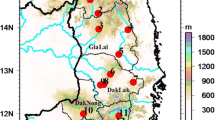Summary
The south Asian summer monsoon from June to September accounts for the greater part of the annual rainfall over most of India and southeast Asia. The evolution of the summer and winter monsoon circulations over India is examined on the basis of the surface and upper air data of stations across India. The salient features of the seasonal reversals of temperature and pressure gradients and winds and the seasonal and synoptic fluctuations of atmospheric humidity are discussed. The space-time variations of rainfall are considered with the help of climatic pentad rainfall charts and diagrams. The rainfall of several north and central Indian stations shows a minimum around mid-August and a maximum around mid-February which seem to be connected with the extreme summer and winter positions of the ITCZ and the associated north-south shifts in the seasonal circulation patterns. Attention is drawn to the characteristic features of the monsoon rainfall that emerge from a study of daily and hourly rainfall of selected stations. Diurnal variations of temperature, pressure, wind and rainfall over the monsoon belt are briefly treated.
Similar content being viewed by others
References
Alvi, S. M. A. andJagannathan, P. (1972),Diurnal variation of pressure in India, Mem. Ind. Met. Dept.3, 1–28.
Ananthakrishnan, R. andKrishnan, A. (1962),Upper air changes over India and neighbourhood associated with the southwest monsoon, Curr. Sci.31, 133–136.
Ananthakrishnan, R., Selvam, M. M. andChellappa, R. (1965),Seasonal variation of precipitable water vapour in the atmosphere, Ind. J. Met. Geophys.16, 371–385.
Ananthakrishnan, R. (1970),The seasonal march of surface pressure gradients and the southwest monsoon, Curr. Sci.39, 248–251.
Ananthakrishnan, R. (1970),Reversal of pressure gradients and wind circulation across India and the southwest monsoon, Quart. J. Roy. Met. Soc.96, 539–542.
Ananthakrishnan, R. andPathan, J. M. (1970),North-south oscillation of the equatorial trough and seasonal variation of rainfall in the tropics, Preprints Sym. Trop. Met., Hawaii, Amer. Met. Soc./W.M.O., FV-1-6.
Ananthakrishnan, R. andPathan, J. M. (1971),Rainfall patterns over India and the adjacent seas, Ind. Met. Dept. Sci. Rep. No. 144.
Ananthakrishnan, R., Suryanarayana, R. andSikka, D. R. (1974),On the diurnal variation of zonal and meridional circulation in the troposphere and lower stratosphere over India, Preprints of the papers presented at the Int. Trop. Met. Meeting, Nairobi, Kenya, Amer. Met. Soc., Boston, 105–108.
Ananthakrishnan, R. (1976),Some aspects of the variability of daily, monthly and annual rainfall at neighbouring pairs of stations and the nature of the monsoon rainfall at individual stations, Proc. Symp. Monsoon, Indian Inst. Trop. Met. Poona, 354–364.
Blanford, H. F. (1888),The rainfall of India, Ind. Met. Mem.3, 658, pp.
Findlater, J. (1969a),A major low level air current near the Indian ocean during the northern summer, Quart, J. Roy. Met. Soc.95, 362–380.
Findlater, J. (1969b),Interhemispheric transport of air in the lower troposphere over the western Indian ocean, Quart. J. Roy. Met. Soc.95, 400–403.
Hahn, D. G. andManabe, S. (1975),The role of mountains in the south Asian monsoon circulation, J. Atmos. Sci.32, 1515–1541.
Holton, J. R.,An Introduction to Dynamic Meteorology (Academic Press, New York, 1972), pp. 70–72.
India Meteorological Department,Climatological Atlas for Airmen (Ind. Met. Dept., New Delhi, 1943).
India Meteorological Department,Rainfall Atlas of India (Ind. Met. Dept., New Delhi, 1971a), 67 pp.
India Meteorological Department,Climatological Atlas of India (Ind. Met. Dept., New Delhi, 1971b), 31–46.
Newell, R. E., Vincent, D. G., Dopplick, T. G., Ferruza, D. andKindson, J. W. (1969),The energy balance of the global atmosphere inThe General Circulation of the Atmosphere (ed. G. A. Corby) (Roy. Met. Soc., London, 1969), pp. 42–90.
Olascoaga, M. J. (1950),Some aspects of Argentine rainfall, Tellus2, 312–318.
Prasad, B. (1970),Diurnal variation of rainfall in India, Ind. J. Met. Geophys.21, 443–450.
Ramanathan, K. R. (1931),The structure of the sea breeze at Poona, Ind. Met. Dept. Sci. Rep. No. 30, Vol. 3, 131–134.
Riehl, H.,Tropical Meteorology (McGraw-Hill, New York, 1954), pp. 12–13, 72–97.
Riehl, H., Cruz, L., Mata, M. andMustur, C. (1973),Precipitation characteristics during the Venezuela rainy season, Quart. J. Roy. Met. Soc.99, 746–757.
Author information
Authors and Affiliations
Rights and permissions
About this article
Cite this article
Ananthakrishnan, R. Some aspects of the monsoon circulation and monsoon rainfall. PAGEOPH 115, 1209–1249 (1977). https://doi.org/10.1007/BF00874407
Received:
Issue Date:
DOI: https://doi.org/10.1007/BF00874407




